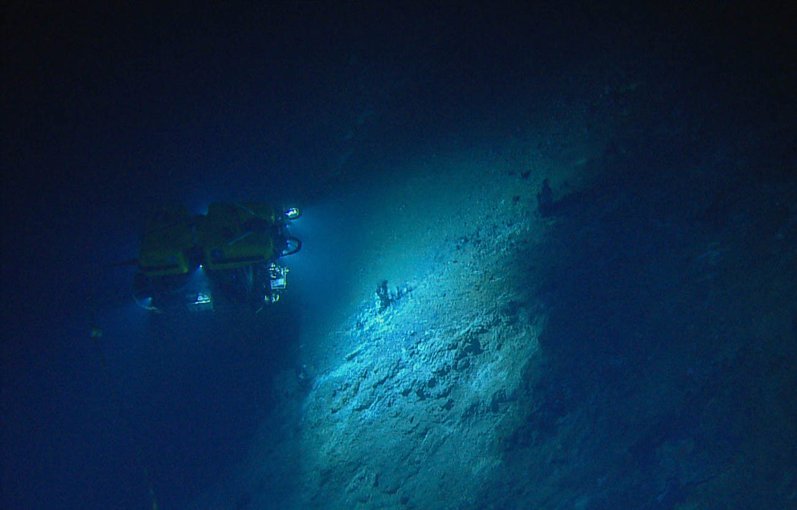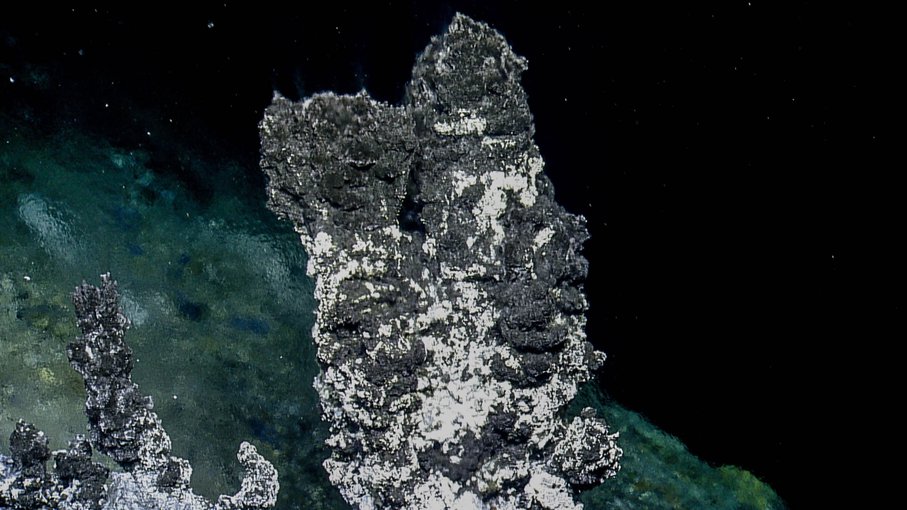
The SUBSEA (Systematic Underwater Biogeochemical Science and Exploration Analog) Research Program team aboard Exploration Vessel Nautilus is thrilled to have discovered a new hydrothermal field at the northern Gorda Ridge in the Pacific Ocean. The team has named it Apollo Vent Field in honor of the 50th anniversary of the moon landing this year, which is fitting since the SUBSEA project isn’t just ocean research – it’s an analog project designed to contribute to the future of space exploration. SUBSEA is a partnership between NASA Science Mission Directorate PSTAR Program, NOAA Office of Ocean Exploration and Research, Ocean Exploration Trust, and multiple academic research centers.

The Exploration Vessel Nautilus exploring the Gorda Ridge in the Pacific Ocean.Image credit: OET/Nautilus Live.
Apollo Vent Field Site Details:
The Apollo vent field offers a rare glimpse into environments that could be windows into ocean systems elsewhere in our Solar System – on moons such as Enceladus and Europa. The Apollo vent field also offers an important comparison to the Sea Cliff hydrothermal site surveyed earlier in this expedition, which was first found in 1990 by Rona et al. and had not been visited in the last ~15 years. Both vent fields are different from the conventional “black smoker” hydrothermal systems, instead emitting clear fluids at temperatures around 300°C. This site was visited on June 6 and 7, 2019 at a depth of ~2700m.
Working with the SUBSEA team, Dr. Shannon Kobs Nawotniak of Idaho State University (ISU) Department of Geosciences, with PhD student Ashley Shields and MS student Angela Garcia, found Apollo Vent Field by closely examining the seafloor shape at Sea Cliff in high resolution bathymetry data. The ISU team used a 1m/pixel bathymetric map (currently under review) created with AUV by Dr. David Clague and his team at Monterey Bay Aquarium Research Institute. The ISU team considered the roughness of the ground, orientation of barely perceptible ridges, and position relative to the Gorda Ridge axis to determine potential hydrothermal sites. When the SUBSEA team finished other science objectives early during one ROV dive, the team was able to ground truth the proposed location, covering ~1500m2 approximately 1 km NE of Sea Cliff Vent Field. Data collected included temperature readings (300°C.), water samples for chemistry and microbiology, and ~0.5 m/pixel bathymetry and backscatter data.

A view of the newly discovered Apollo Vent Field at the northern Gorda Ridge in the Pacific Ocean.Image credit: OET/Nautilus Live.
SUBSEA Expedition Summary:
This discovery was made during a NASA mission to the deep sea, called the Systematic Underwater Biogeochemical Science and Exploration Analog, or SUBSEA for short. In 2019, SUBSEA is exploring Gorda Ridge, an underwater volcanic zone located in the Pacific Ocean, about 75 miles off the U.S. coast where California and Oregon meet. This environment shares key characteristics with Saturn’s moon Enceladus. The team is looking for signs of microbial life in the warm springs emanating from the volcano and studying the conditions that make life possible here. This work will help understand the potential for other ocean-bearing worlds in the solar system to support life and will inform designs for future deep-space missions. SUBSEA is a partnership between NASA Science Mission Directorate PSTAR Program, NOAA Office of Ocean Exploration and Research (OER), Ocean Exploration Trust, and multiple academic research centers.

Close-up of features at the Apollo Vent Field.Image credit: OET/Nautilus Live.
About Ocean Exploration Trust
The Exploration Vessel (E/V) Nautilus is the research platform supporting this project, and is equipped with remotely operated vehicles (ROVs) Hercules and Argus used to dive on targets, collect samples, and capture high definition video, supported by a dynamic positioning system and a multibeam sonar mapping system. E/V Nautilus is owned and operated by the Ocean Exploration Trust (OET), founded in 2008 by Dr. Robert Ballard to explore the ocean, seeking out new discoveries in the fields of geology, biology, maritime history, and archaeology while pushing the boundaries of STEM education and technological innovation. Their international program offers live exploration to participants on shore and the public via live video, audio, and data feeds on www.nautiluslive.org.
This discovery was made at a timely moment as OET kicks off #WorldOceansDay and #WorldOceansMonth with partners at NOAAOER, NASA, and Schmidt Ocean Institute in taking a look at the connections between our ocean on Earth as well as oceans elsewhere in our solar system.

The Exploration Vessel Nautilus deployed at the Apollo Vent Field.Image credit: OET/Nautilus Live.
Additional Links:
Newly discovered Apollo Vent Field in Pacific by ISU researchers offers glimpse of alien worlds (ISU)
Nautilus Live Expedition Page
SUBSEA Research Program website
Live streaming website: www.NautilusLive.org
Twitter: www.twitter.com/evNautilus
Facebook: www.facebook.com/NautilusLive
Instagram: www.instagram.com/Nautiluslive
YouTube: www.youtube.com/EVNautilus
Hashtag: #NautilusLive


